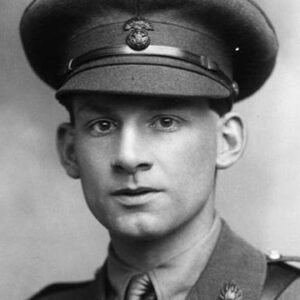Siegfried Sassoon was a distinguished historian, poet, writer, and soldier who became one of the most iconic individuals of the twentieth century. During World War I, he was one of the first writers to write poetry that depicted the war’s horrific reality in vivid detail. His poems revealed the harsh, barbaric, and cold-blooded realities on the war front in a period when people were enticed by patriotic propaganda and romantic, heroic conceptions of battle. Details of foul-smelling decaying corpses, malformed limbs, squalor, suicide, and blood served as a powerful anti-war position in all of his works. This form of writing had a big influence on the modernist poetry genre. ‘The Old Huntsman,’ ‘The Hero,’ ‘Aftermath,’ ‘I Stood with the Dead,’ ‘Trench Duty,’ and ‘Repression of War’ are only a few of his well-known poetry. He refused to return to service, disillusioned with war, and fiercely criticized it. He published a series of semi-autobiographical works, including ‘Memoirs of a Fox-Hunting Man,’ ‘Memoirs of an Infantry Officer,’ and ‘Sherston’s Progress,’ as a witness to immense violence. The ‘Sherston trio’ was named after this sequence of works. Continue reading this biography to gain more intriguing details about his personal life, youth, and combat experiences.
Childhood and Adolescence
Siegfried Sassoon was born to a Jewish father, Alfred Ezra Sassoon, a descendant of a rich Baghdad merchant family, and an Anglo-Catholic mother, Theresa. From 1905 to 1907, he attended The New Beacon Preparatory School in Sevenoaks, Kent, then majored in history at Clare College, Cambridge. He quit college and spent the following few years hunting, cricketing, reading, and composing poems. At the time, some of his poetry was secretly published under a pen name.
Career of Siegfried Sassoon
In his 1913 piece, ‘The Daffodil Murderer,’ Siegfried Sassoon articulated his views on the pre-World War I political landscape. ‘The Everlasting Mercy,’ by John Masefield, was parodied. He enlisted in the British Army just before the outbreak of World War I, joining the ‘Sussex Yeomanry,’ a British Army unit, on August 4, 1914. It was also the day the United Kingdom declared war on Germany.
After sustaining an injury to his right arm in a riding accident, he spent the spring of 1915 healing. Sassoon’s younger brother, Hamo, was killed in battle at this time, which had a significant impact on him. He was commissioned as a second lieutenant in the ‘Royal Welsh Fusiliers,’ a British infantry unit, in May 1915. In France, he was sent to the Western Front.
He uncovered a German trench with 60 or so German soldiers in it while on duty on the Western Front; equipped only with grenades, he took the position. For his bravery, he received a lot of praise. He intended to campaign against the war after the tragic loss of a close friend in the war, and in 1917, he finally resolved to take a position against the war’s conduct.
He was shot in the head by a fellow soldier who mistaken him for a German and shot him while on duty in 1918.
In 1919, he took a job as literary editor at the Daily Herald, a British daily newspaper, after being dismissed from the military.
In 1928, he published ‘Memoirs of a Fox-Hunting Man,’ the first semi-autobiographical novel, which is considered a masterpiece in English literature. In 1930, he released his second semi-autobiographical work, ‘Memoirs of an Infantry Officer,’ which tells the story of his life during and after World War I. ‘Sherston’s Progress,’ the concluding installment of his semi-autobiographical trilogy, was released in 1936.
Major Works of Siegfried Sassoon
‘Memoirs of a Fox-Hunting Man,’ published in 1928, is considered a classic in English literature and is taught in schools. The Hawthornden Prize and the James Tait Black Memorial Prize were awarded to the novel. The ‘Sherston trilogy’ — ‘Memoirs of a Fox-Hunting Man,’ ‘Memoirs of an Infantry Officer,’ and ‘Sherston’s Progress’ – established Sassoon as one of the most prolific authors of the century.
Achievements & Awards
He was awarded the Military Cross on July 27, 1916, in honor of active operations against the enemy on land. In 1951, he was named Commander of the Order of the British Empire, an official distinction bestowed as part of the Commonwealth Realms’ New Year Honours.
Personal History and Legacy
He loved cricket and was a member of the Matfield and Downside Abbey teams until the late 1970s. William Park, ‘Gabriel’ Atkin, actor Ivor Novello; Novello’s old boyfriend, Glen Byam Shaw; German nobleman Prince Philipp of Hesse; writer Beverley Nichols; and an effete aristocrat, the Hon. Stephen Tennant were all romantically engaged with him.
He married Hester Gatty in 1933, and they had a son named George. He died of stomach cancer later in life and is buried at Mells, Somerset’s St Andrew’s Church. He is one of sixteen “Great War poets” commemorated on a slate stone installed at Westminster Abbey’s Poet’s Corner.
Estimated Net Worth
Siegfried is one of the wealthiest poets and one of the most well-known. Siegfried Sassoon’s net worth is estimated to be $1.5 million, according to Wikipedia, Forbes, and Business Insider.


